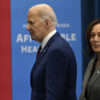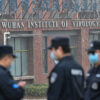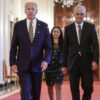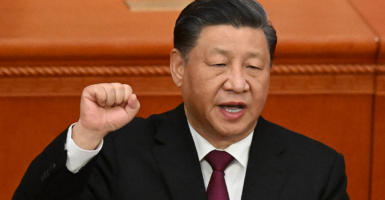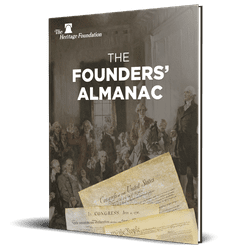China’s infiltration of American K-12 schools is “almost everywhere,” according to Peter Wood, president of the National Association of Scholars.
“That is, in every state that we’ve looked at, we have found instances of it, but I would say it’s concentrated in the feeder schools to elite education, which means mostly West Coast and East Coast, but not exclusively those,” Wood says.
“The effort here is, China’s not just spreading around its resources promiscuously across the land. It’s looking for places where buying influence will yield results in the long term,” he adds. “So, it’s widespread, but much more prevalent here on the East Coast and California.”
In April, The Heritage Foundation awarded the National Association of Scholars its Innovation Prize, which “is intended to spark creative disruption in the conservative movement as we strive to ensure the future of American self-governance.” (The Daily Signal is the news outlet of The Heritage Foundation.)
Wood joins today’s episode of “The Daily Signal Podcast” to discuss some of the concerns surrounding the Chinese Communist Party’s influence in our education system and some of the other work the National Association of Scholars has been doing in addition to digging into China’s infiltration of and influence in K-12 schools.
Listen to the podcast or read a lightly edited transcript of today’s interview below:
Samantha Aschieris: Peter Wood is joining today’s episode of “The Daily Signal Podcast.” Peter has been the president of the National Association of Scholars since 2009. Earlier this year, the National Association of Scholars was awarded The Heritage Foundation’s Innovation Prize for its work related to Communist China.
Peter, thanks so much for joining us today.
Peter Wood: Well, thank you so much for having me.
Aschieris: Of course. Now, before we get any further with our conversation today, can you tell us a little bit more about the National Association of Scholars?
Wood: We were founded in the mid-1980s as among the first serious efforts to push back against what was then recognized as political correctness.
A group of several hundred faculty members from around the country created the organization. It thrived pretty well during the 1990s and then as it became clear that we were basically losing the battle against political correctness, it faded for a while.
But we’ve been back strong in the last 15 years or so and are actively looking for those places where we think there’s serious leverage that could be brought against our colleges’ and universities’ dissent into a kind of ideological madness that has overtaken that sector of our society.
Aschieris: And as I mentioned earlier, the National Association of Scholars was awarded The Heritage Foundation’s Innovation Prize and that was for a project related to China known as “Corrupting the Classroom: Confucius Classrooms and the CCP’s Infiltration of American K-12 Education.” Tell us a little bit more about this project.
Wood: Well, the project is the direct outgrowth of a project that we started working on almost 10 years ago when we identified Confucius Institutes at the college level as a project that was being run by the Chinese Communist Party to gain access to an influence over American colleges and universities. We produced some hefty reports on that, that got the attention of members of Congress as well as some administrative agencies.
And although the Chinese Communist Party fought back, after a while they realized that they had a branding problem and they decided to remove the name Confucius Institutes to these entities on our college campuses and have them go dark.
Now, the American press oftentimes misreported that as the actual closing of the institutes and their disappearance, where in fact what really happened is that they got renamed, relabeled, moved around a little bit, but China was not to be defeated that easily.
While we were working on the Confucius Institutes, we gained some knowledge of the junior version of Confucius Institutes, Confucius Classrooms, which were being spotted in American K-12 education around the country, oftentimes at the sorts of schools that were feeders to elite colleges and universities.
So they wanted to get access to America’s students at an even younger age and make sure they were well-disposed toward China, at least China in the version of it that the Chinese Communist Party sees fit to share.
So that’s what we’re doing now. And with the help of Heritage’s prize money on this, we are delving into what these Confucius Classrooms are actually doing.
Now, in some ways, it’s a harder target for us than the Confucius Institutes. The institutes had an institutional structure that made them fairly easy to spot. The Confucius Classrooms don’t have a single name for them. They go under many different names, and the schools that have them are being very cagey about what they are and what they’re doing.
So this is requiring a fair amount of on-the-ground poking around and research to get hold of important information.
Aschieris: Definitely. And it is such an important topic, especially when we think about the Chinese Communist Party’s infiltration of American K-12 schools, as we’ve been talking about.
And one thing I wanted to ask you about are some of the concerns surrounding CCP influence in our education system, especially as you have been digging into at National Association of Scholars in the K-12 level.
Wood: Well, part of this is simply propagandizing the students so that they learn about China, but they don’t learn about the South China Sea, which is being heavily militarized by China. They don’t learn about the plight of the Uyghurs, the efforts to gauge in organ harvesting, the efforts to suppress Tibet.
There are in China so many policies that violate human rights and which signal the aggressiveness of the regime there, which has its designs on becoming a worldwide hegemon, that need to be presented to Americans in a softer light.
So what’s happening in these schools is that they learn that China is a benevolent institution, the heir of an ancient civilization that means nothing but goodwill to the rest of the world. So there’s that aspect to it as well.
And the notion that you can take children who have some aptitude for the hard sciences and math and get them to view China as a potential partner and friend, I think, is very disturbing as well.
So we have, on one hand, the broad misleading imaging of China, but also the notion that China can be a partner to these students all through their educational careers. We’re creating an assembly line for talented young men and women who will be unable to distinguish the American national interest from the Chinese national interest. They’re getting blurred together at a young age and that’s very difficult to undo once it’s done.
Aschieris: Definitely. Something else I was curious about, and this could relate back to the Confucius Institutes and how widespread they were throughout the country, I know a number of those institutes have closed. When we’re looking at the K-12 school infiltration, how widespread is that throughout the U.S.? Is it in certain states? Is it in certain areas of the country? What have you been finding?
Wood: Well, it’s almost everywhere. That is in every state that we’ve looked at, we have found instances of it, but I would say it’s concentrated in the feeder schools to elite education, which means mostly West Coast and East Coast, but not exclusively those.
The effort here is China’s not just spreading around its resources promiscuously across the land, it’s looking for places where buying influence will yield results in the long term. So it’s widespread but much more prevalent here on the East Coast and California.
Aschieris: That’s super interesting. One thing, from a parental perspective, in terms of being more active in what their kids are learning, maybe listening to this episode—we’ve done a few other episodes, a few other interviews on this issue of Confucius Classrooms, this infiltration in K-12 schools. What should parents be looking for as the school year is getting back into the swing of things? What would you suggest they be on the lookout for for potential influence from China?
Wood: I think if they find their children learning Chinese phrases and are becoming interested in what’s going on in China, a few diagnostic questions about, “Well, what have you learned about the Uyghurs? What have you learned about Tibet?”, might tip the parents off that the kind of education they’re getting is skewed toward one side of the picture.
Another thing to look for is, who’s doing the teaching? Do any of the teachers themselves happen to be seconded here by China? That is, most of our schools’ teaching is done by American educated teachers, but the Confucius Classrooms involved a certain amount of bringing in people approved by the Hanban, the Chinese agency that runs these things. So knowing who the teachers are counts.
If the children are bringing home textbooks or printed material, that too is a good giveaway because China supplies that material, and you can imagine the material that it is supplying to the classrooms is not objective, it is there for a purpose. And those are all good ways to flag a Confucius Classroom in operation.
What you can’t really do is ask your school directly, “Do you have a Confucius Classroom?” They may not be familiar with the term, if they’re honest, but if they have something to hide, they just will say, “No.” And that’s where a little bit of independent digging is required.
Aschieris: Definitely. And before we shift topics, I just wanted to get your thoughts on what can or should be done at the federal and state level in terms of legislation regarding Confucius Classrooms, Chinese infiltration in K-12 schools. Obviously, Congress is in recess right now, but what would you like to see them focus on regarding this issue when they return in September?
Wood: I would like them to cut off the money supply. I don’t think American schools need to be financially supported by foreign powers. This is true not only of China, but of other nations that have realized that they can gain influence in the U.S. via our schools.
So the cleanest solution would not be one that singles out China, but one which says that American schools should not be funded by foreign powers, especially by foreign powers that are adversaries of the United States, if not declared enemies.
So that would go a long way. But in addition to that, or maybe it’s instead of it in some cases, would be a demand for transparency. That if you are going to be involved with having a program that is created, funded, orchestrated by some other nation, you have to tell the parents, the students, and state what you’re doing.
Having all this happen behind a veil is a terrible idea. We’ve got enough of our own problems in K-12 education in this country that we don’t need to import new ones.
Aschieris: Now, Peter, just before we go, I wanted to just circle back to what we were talking about in the beginning with just the National Association of Scholars, and if you could tell us a little bit more about the other great work that you’ve been doing in addition to digging into China’s infiltration and influence of K-12 schools.
Wood: Well, we’re multifront organization. We are, for example, taking a look at how the diversity, equity, inclusion doctrine has become established in faculty recruitment around the country and how it has affected the curricula of colleges as well as K-12 education.
We are a prolific proposer of legislation at the state level to fix these things. And some of our proposals have taken root and made their way into law already or are in the process of becoming law.
We work on the issues of fighting against the progressive censorship of faculty members as well as curricula. So when individuals are fired for having said something that is truthful but untimely, we go to bat for them. So a fair amount of our work is trying to fix that.
We have been paying a lot of attention now for about a decade to the explosion in administrative staff in colleges, which now far outnumbers in actual headcount the faculty members of most colleges and universities. And we’ve been looking at the student debt crisis and what can be done about that.
But just about any issue that points toward the mischief that has been created by progressive domination of colleges and universities, we have our hand in. And we’ve been gratified over the last decade or so by the turn in public attention.
It used to be that it was very difficult to get parents and students and faculty members, for that matter, really interested in trying to repair what had gone wrong. But nowadays, that’s not the case.
The parents around the country have risen up in effect. Almost every day I’m hearing from people who would not normally have been writing to an organization with “scholars” in its name saying, “How can you help me?”, or, “What can I do to help you?”
And I think that there has just been this sea change in the American public’s attitude toward education generally that has taken the form, if you believe the Gallup polls, that Americans now look with, I wouldn’t say it’s disdain, but they look with discomfort on what goes on in classrooms at every level, and that this has been brought about by the Left’s heedless crowing of victory.
They thought they had taken over these institutions once and for all. They were getting good return on their investment in the form of anything from [George] Soros’ prosecutors to majority control of various houses of the legislatures in many, many states. And they just got complacent about it, “Oh, we can do anything. We can even force people to say that there aren’t two sexes, but there’s 87 genders or whatever.”
All these extremely aggressive efforts to control what people can say and think have brought about a reaction. Now, I don’t particularly like being called a reactionary, but yes, we are reacting against the destruction of a noble institution, and not just a noble institution, but one that is crucial to the survival of our civilization and our prosperity as a nation.
So we all agree that education is important, but it’s taken a while for conservatives and just middle-of-the-road people to come around to realizing that all that is at risk and we need to do something.
So I’m grateful for the help that Heritage is giving us and many other things that Heritage is doing to advance this cause. It wasn’t always the case that education was at the top of the list of things that The Heritage Foundation presented as its agenda, but it is now, and I think that too is evidence that something has decisively changed in American life.
Aschieris: Well, Peter, thank you so much for joining us today. Before we go, I just wanted to ask how people can learn more about the National Association of Scholars and the work that you’ve been doing.
Wood: Our website, which is a very simple, nas.org, is the perfect place to learn about what we’re doing. We publish a daily magazine called Minding the Campus, which is accessible through the website or just at Minding the Campus. Those are two good ways to find out what we’re up to.
Aschieris: Awesome. Thank you so much. I’ll definitely make sure to leave a link to the association’s website in the show notes so people can check that out. Peter Wood, thanks so much for joining us.
Wood: Great. And thank you for having me.
Have an opinion about this article? To sound off, please email letters@DailySignal.com and we’ll consider publishing your edited remarks in our regular “We Hear You” feature. Remember to include the url or headline of the article plus your name and town and/or state.





